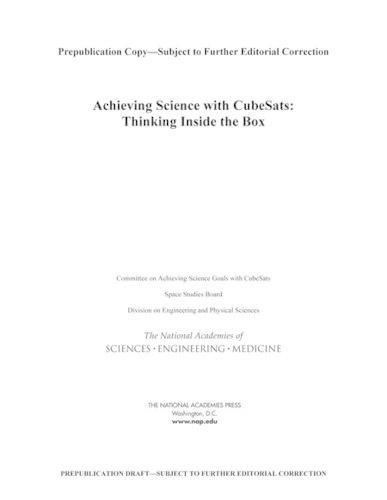Achieving Science with CubeSats: Thinking Inside the Box
National Academies of Sciences, Engineering, and Medicine,Division on Engineering and Physical Sciences,Space Studies Board,Committee on Achieving Science Goals with CubeSats

Achieving Science with CubeSats: Thinking Inside the Box
National Academies of Sciences, Engineering, and Medicine,Division on Engineering and Physical Sciences,Space Studies Board,Committee on Achieving Science Goals with CubeSats
Space-based observations have transformed our understanding of Earth, its environment, the solar system and the universe at large. During past decades, driven by increasingly advanced science questions, space observatories have become more sophisticated and more complex, with costs often growing to billions of dollars. Although these kinds of ever-more-sophisticated missions will continue into the future, small satellites, ranging in mass between 500 kg to 0.1 kg, are gaining momentum as an additional means to address targeted science questions in a rapid, and possibly more affordable, manner. Within the category of small satellites, CubeSats have emerged as a space-platform defined in terms of (10 cm x 10 cm x 10 cm)- sized cubic units of approximately 1.3 kg each called U’s. Historically, CubeSats were developed as training projects to expose students to the challenges of real-world engineering practices and system design. Yet, their use has rapidly spread within academia, industry, and government agencies both nationally and internationally.
In particular, CubeSats have caught the attention of parts of the U.S. space science community, which sees this platform, despite its inherent constraints, as a way to affordably access space and perform unique measurements of scientific value. The first science results from such CubeSats have only recently become available; however, questions remain regarding the scientific potential and technological promise of CubeSats in the future.
Achieving Science with CubeSats reviews the current state of the scientific potential and technological promise of CubeSats. This report focuses on the platform’s promise to obtain high- priority science data, as defined in recent decadal surveys in astronomy and astrophysics, Earth science and applications from space, planetary science, and solar and space physics (heliophysics); the science priorities identified in the 2014 NASA Science Plan; and the potential for CubeSats to advance biology and microgravity research. It provides a list of sample science goals for CubeSats, many of which address targeted science, often in coordination with other spacecraft, or use sacrificial, or high-risk, orbits that lead to the demise of the satellite after critical data have been collected. Other goals relate to the use of CubeSats as constellations or swarms deploying tens to hundreds of CubeSats that function as one distributed array of measurements.
This item is not currently in-stock. It can be ordered online and is expected to ship in approx 4 weeks
Our stock data is updated periodically, and availability may change throughout the day for in-demand items. Please call the relevant shop for the most current stock information. Prices are subject to change without notice.
Sign in or become a Readings Member to add this title to a wishlist.


